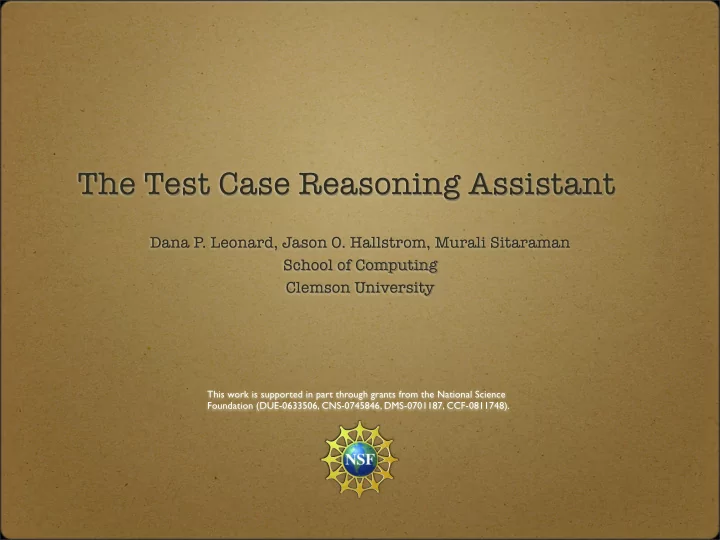

The Test Case Reasoning Assistant Dana P. Leonard, Jason O. Hallstrom, Murali Sitaraman School of Computing Clemson University This work is supported in part through grants from the National Science Foundation (DUE-0633506, CNS-0745846, DMS-0701187, CCF-0811748).
Course Module Target Any course where interface contracts can be introduced Objectives Reading and interpreting formal specifications Understanding abstract models of SW behavior Using components based on contract understanding Approach Teach students to read, interpret, and apply interface specifications using test point creation exercises
Pilot Studies CpSc 215: Software Development Foundations CS 349: Software Engineering CpSc 372: Software Engineering Foundations
Exercise #1 Function Mystery( preserves x : Integer) : Integer requires x >= 0 ensures ( result * result <= x) and (( result + 1) * ( result + 1)) > x Question What does the mystery function compute? Solution Strategy Develop test cases that satisfy the specification #x result check ? 0 0 (0*0 ≤ 0) ∧ (1*1 > 0) 1 1 (1*1 ≤ 1) ∧ (2*2 > 1) 4 3 (3*3 ≤ 4) ∧ (4*4 > 4) 18 4 (4*4 ≤ 18) ∧ (5*5 > 18)
Exercise #2 Function Mystery( preserves x : Integer) : Boolean requires x > 2 ensures Mystery() = there exists k, m : Integer s.t. (k >= 2) and (m >= 2) and (x = k * m) #x result check ? 4 TRUE ∃ k,m : (k ≥ 2) ∧ (m ≥ 2) ∧ (4 = k*m) 7 FALSE ∃ k,m : (k ≥ 2) ∧ (m ≥ 2) ∧ (7 = k*m) 13 TRUE ∃ k,m : (k ≥ 2) ∧ (m ≥ 2) ∧ (13 = k*m) 22 TRUE ∃ k,m : (k ≥ 2) ∧ (m ≥ 2) ∧ (22 = k*m) Question What does the mystery function compute?
Abstract Models Later, students are taught to reason about component behavior using abstract mathematical models Theory Str(Integer) : mathematical string of integers examples : <>, <1>, <2, 1>, <3, 1, 2>, <4, 1, 2, 3> concatenation : <> o <1> = <1>, <1, 2> o <5, 6> = <1, 2, 5, 6> length : |<>| = 0, |<1, 3, 2>| = 3 Specification Stack is modeled by Str(Entry) Operation Push( updates s : Stack, preserves x : Entry) ensures s = <x> o #s Operation Pop( updates s : Stack, produces x : Entry) ensures #s = <x> o s Operation Length( preserves s : Stack) ensures result = |s|
Exercise #3 Operation Mystery( updates s : Stack, preserves x : Integer) requires x <= |self| ensures there exists l, r : Str(Entry) s.t. (#s = l o r) and (|l| = x) and (s = r o l) #s #x s check ? ∃ l,r : (<> = l o r) ∧ (|l| = 0) ∧ <> 0 <> (<> = r o l) ∃ l,r : (<1> = l o r) ∧ (|l| = 1) ∧ <1> 1 <1> (<1> = r o l) ∃ l,r : (<1,2,3> = l o r) ∧ (|l| = 2) ∧ <1,2,3> 2 <2,3,1> (<2,3,1> = r o l) ∃ l,r : (<1,2,3,4,5> = l o r) ∧ (|l| = 3) ∧ <1,2,3,4,5> 3 <4,5,1,2,3> (<4,5,1,2,3> = r o l)
The Reasoning Workbench Smart classrooms enable new teaching tools and exercises that enhance the learning process: Excite and engage students Provide real-time performance feedback Monitor student learning and identify problem areas The Reasoning Workbench A collection of reasoning assistants that guide students through reasoning exercises and provide real-time feedback as they work
Test Case Reasoning Assistant Test Case Reasoning Assistant (TCRA) Workbench Purpose Assist students in developing test cases that measure and reinforce their understanding of abstract models and interface specifications
TCRA Overview Student Instructor Interface Interface performance data Exercise Repository public class StackExercise implements TCRAExercise { individual / aggregate presentation checking performance summaries }
TCRA Student Interface
TCRA Instructor Interface
Additional Modules More advanced modules require students to rely on specifications as part of their development work Contract Development in Teams Medium-scale project subdivided into components Students work independently using formal contracts Systems composed from selected implementations Tool-Assisted Program Verification Students derive simple verification conditions (VCs) Derivation process is reinforced using VC generator Students prove generated VCs using proof assistant
Questions? The Test Case Reasoning Assistant Dana P. Leonard, Jason O. Hallstrom, Murali Sitaraman School of Computing Clemson University This work is supported in part through grants from the National Science Foundation (DUE-0633506, CNS-0745846, DMS-0701187, CCF-0811748).
Recommend
More recommend